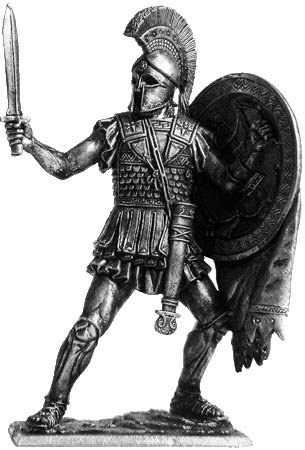Battle of Marathon part2
The campaign
But Darius was not going to give up on his plans for punishing the Athenians. Thus in the following year another expedition was being prepared which would move across the Aegean to punish the Athenians and Eretrians, who had also supported the revolt, by burning their cities and enslaving the populations. This force would be totally transported by sea, thereby avoiding the problems that had beset Mardonius' expedition. The naval component of the expedition was composed of nearly 600 ships. Perhaps 200 of these were warships serving as the fleet's escort while the remaining 400 were transports that would carry the troops and their supplies. The transports included a number of specially designed horse transport to carry the mounts for the Persian cavalry. The landing force numbered perhaps 25,000 fighting men including a small cavalry contingent, probably about 1000 strong. This force was commanded by Darius' nephew Artaphernes and Datis, a nobleman of Median descent. Also present was Hippias, who had ruled Athens as a tyrant until he was expelled in 510BC. The Persians understood the fractious nature of politics in a Greek city-state and no doubt saw the potential of using Hippias to raise a fifth column within Athens itself.
The Persian fleet set sail from Tarsus and sailed westwards. The armada put ashore at a number of islands along the way and reduced them either through threat or the use of force. A major landing was made on the island of Euboea in order to attack the city of Eretria, singled out, along with Athens, by Darius for punishment on account of their role in supporting the Ionian revolt. The people of Eretria were in a quandary as to what to do in the face of such a powerful force.
Some were in favour of trying to hold the town while others argued for abandoning the city and continuing to fight from nearby hills. But before a decision could be made the town was handed over by a faction who had been bribed with Persian gold in exchange for opening the gates of the town to the enemy, The temples of the city were burned in retribution for the destruction at Sardis. From Euboea the Persians headed to Attica, landing at the plain of Marathon on 5 August, nearly 26 miles from Athens. The landing spot was undoubtedly chosen in consultation with Hippias since it provided everything the Persians required, including a long beach where their ships could be brought ashore, an ample water supply, access to Athens, and room to manoeuvre, especially for their cavalry, should the Athenians choose to give battle there.
When the Athenians learned of the Persians' landing, they immediately sent for aid - the herald Philippides' most famously ran 140 miles to Sparta. Unfortunately, the Spartans were not able to send help on account of a religious festival, the Carneia, which would not allow them to march until 12 August. With this news, the Athenians debated their course of action. Some were in favour of preparing for a siege - although given Hippias' presence and the treachery at Eretria, this seemed rather risky. Others argued that it was imperative to keep the Persians penned in at Marathon and not allow them to reach the city. Included in this group was the general Militiades. His opinion carried some weight since he had previous dealings with the Persians and had fought in the Ionian revolt. As a result, the Athenian army of nearly 10,000 hoplites, heavily-armed infantry, marched out to Marathon. They were joined by a force of between 600 and 1000 hoplites from the city of Plataea, a longtime ally of Athens.
